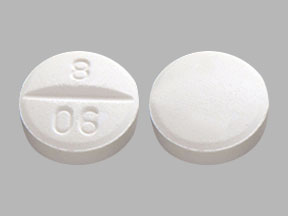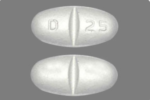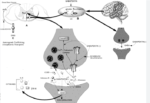Trazodone is sometimes used off-label to treat fibromyalgia, a chronic condition characterized by widespread musculoskeletal pain, fatigue, and sleep disturbances. Though it’s not a first-line treatment for fibromyalgia, its sedative and antidepressant properties make it beneficial for managing some of the condition’s symptoms, particularly sleep problems and mood disturbances.
Fibromyalgia is thought to involve dysregulation of neurotransmitters, particularly serotonin, norepinephrine, and dopamine, as well as disrupted sleep patterns. Trazodone helps by addressing both the sleep disturbances and the emotional distress that can exacerbate fibromyalgia symptoms.
Fibromyalgia is a chronic disorder characterized by widespread musculoskeletal pain, often accompanied by fatigue, sleep disturbances, memory issues, and mood disorders. It affects how the brain processes pain signals, leading to an amplified sensation of pain. While the exact cause is unknown, it’s believed that fibromyalgia results from a combination of genetic, environmental, and psychological factors.
Key Symptoms of Fibromyalgia:
- Widespread Pain:
- Pain in fibromyalgia is typically described as a constant, dull ache that lasts for at least three months and occurs on both sides of the body and above and below the waist. It may feel like a deep muscle ache or radiating joint pain, although the joints themselves aren’t affected.
- Fatigue:
- People with fibromyalgia often wake up feeling tired, even after sleeping for long periods. Non-restorative sleep is a common issue, with frequent awakenings and disruptions, contributing to fatigue.
- Cognitive Difficulties (“Fibro Fog”):
- Many individuals experience cognitive issues, often referred to as fibro fog. This includes problems with memory, concentration, and focus.
- Sleep Disturbances:
- Insomnia or difficulty staying asleep is common. Many people also have other sleep disorders, such as restless legs syndrome or sleep apnea, which further disrupt sleep and contribute to fatigue.
- Mood Disorders:
- Depression and anxiety are common in fibromyalgia patients. The chronic pain and fatigue can significantly impact a person’s emotional well-being, leading to psychological distress.
- Sensitivity to Touch:
- Fibromyalgia patients often have tender points or trigger points, which are specific spots on the body (like the neck, back, shoulders, hips, and knees) that are painful when pressed.
- Other Symptoms:
- Irritable bowel syndrome (IBS).
- Headaches or migraines.
- Sensitivity to light, sound, or temperature.
- Bladder issues such as interstitial cystitis.
- Numbness or tingling in the hands and feet.
Causes of Fibromyalgia:
The exact cause of fibromyalgia is unknown, but several factors are believed to contribute to its development:
- Genetics: Fibromyalgia often runs in families, suggesting a genetic predisposition.
- Infections: Some illnesses appear to trigger or exacerbate fibromyalgia symptoms.
- Physical or Emotional Trauma: Trauma, such as surgery or psychological stress, may trigger fibromyalgia in some people.
- Abnormal Pain Processing: People with fibromyalgia have altered pain signaling in the brain, leading to heightened sensitivity to pain stimuli, a phenomenon known as central sensitization.
Diagnosis of Fibromyalgia:
There are no specific laboratory tests or imaging studies to diagnose fibromyalgia. Doctors primarily rely on patient history and physical examination. Diagnostic criteria include:
- Widespread pain lasting more than three months.
- Presence of other symptoms like fatigue, non-restorative sleep, and cognitive issues.
- Ruling out other conditions that may cause similar symptoms, such as rheumatoid arthritis or lupus.
Treatment Options for Fibromyalgia:
Treatment focuses on managing symptoms and improving quality of life since there is no cure. A multidisciplinary approach involving medications, lifestyle changes, and alternative therapies is typically most effective.
1. Medications:
- Pain relievers: Over-the-counter pain medications like acetaminophen or NSAIDs (ibuprofen, naproxen) may be helpful but are generally less effective for fibromyalgia pain.
- Antidepressants: Drugs such as duloxetine (Cymbalta) and milnacipran (Savella) can help manage pain and fatigue by increasing serotonin and norepinephrine levels in the brain.
- Anticonvulsants: Pregabalin (Lyrica) and gabapentin (Neurontin) are sometimes prescribed for nerve-related pain and work by calming overactive nerves.
- Sleep aids: Medications like trazodone (as discussed earlier) or low doses of amitriptyline are used to improve sleep quality.
2. Lifestyle Changes:
- Exercise: Low-impact aerobic exercise, such as walking, swimming, or cycling, is one of the most effective treatments for fibromyalgia. It can reduce pain, improve mood, and increase energy levels. Stretching and strengthening exercises can also be beneficial.
- Stress management: Practicing mindfulness, meditation, deep breathing, or yoga can help reduce stress, which is known to worsen symptoms.
- Healthy sleep habits: Establishing a regular sleep routine, reducing caffeine, and avoiding electronics before bed can improve sleep quality.
3. Cognitive Behavioral Therapy (CBT):
- CBT is a form of talk therapy that helps patients manage their response to chronic pain and improve their coping mechanisms. It can also address depression and anxiety associated with fibromyalgia.
4. Alternative Therapies:
- Some patients find relief through complementary therapies such as acupuncture, massage, or chiropractic care. Tai chi and yoga are also recommended as they combine physical movement with mental focus, which can be particularly helpful for managing fibromyalgia symptoms.
Prognosis:
Fibromyalgia is a chronic condition, meaning that symptoms may persist throughout life. However, with appropriate management, many people are able to live full, productive lives. A combination of medication, lifestyle changes, and psychological support can significantly reduce symptoms and improve quality of life.
How Trazodone Works for Fibromyalgia ?
1. Improvement of Sleep Quality:
- Mechanism: One of the hallmark symptoms of fibromyalgia is poor sleep, including difficulties in falling asleep and maintaining deep, restorative sleep. Trazodone’s sedative effects, which result from its histamine H1 receptor antagonism and alpha-1 adrenergic blockade, promote drowsiness and improve sleep quality.
- Benefit: By promoting deep (non-REM) sleep, trazodone can help reduce the fatigue and general unwellness that fibromyalgia patients experience due to sleep disturbances. Improved sleep also helps reduce pain perception, as lack of sleep worsens fibromyalgia pain.
2. Serotonin Modulation:
- Mechanism: Fibromyalgia may involve serotonin dysregulation, affecting both pain perception and mood. Trazodone is a serotonin antagonist and reuptake inhibitor (SARI), meaning it increases serotonin availability by blocking its reuptake, while also modulating certain serotonin receptors (5-HT2A).
- Benefit: By increasing serotonin levels, trazodone helps regulate mood and may reduce the overall perception of pain. This is especially important because people with fibromyalgia often experience anxiety, depression, and emotional stress, all of which can exacerbate pain.
3. Reduction of Pain Sensitivity:
- Mechanism: Chronic pain in fibromyalgia is believed to be linked to abnormalities in how the central nervous system processes pain signals, sometimes referred to as central sensitization. Trazodone’s ability to modulate serotonin and norepinephrine can influence the body’s pain threshold, potentially reducing the hypersensitivity to pain that is characteristic of fibromyalgia.
- Benefit: By improving the body’s response to pain, trazodone may help reduce the intensity of fibromyalgia-related pain, though this is more of an indirect effect through improved sleep and mood rather than direct pain relief.
Typical Dosage for Fibromyalgia:
- Low doses are typically used when trazodone is prescribed for sleep disturbances and pain in fibromyalgia patients. Common starting doses are around 25–50 mg at bedtime, which is significantly lower than doses used for treating depression (typically 150–300 mg per day).
- Long-term use: Trazodone is often used as a part of a multimodal treatment plan that includes lifestyle changes, exercise, and possibly other medications such as pregabalin or duloxetine that target fibromyalgia pain more directly.
Benefits of Trazodone for Fibromyalgia:
- Improves sleep, which can reduce fatigue and enhance quality of life.
- Elevates mood and addresses co-occurring depression or anxiety that are common in fibromyalgia patients.
- Reduces pain perception by addressing the underlying neurotransmitter dysregulation associated with fibromyalgia.
Potential Side Effects:
Though trazodone is generally well-tolerated, it can cause some side effects, especially when used at higher doses:
- Drowsiness or next-day fatigue.
- Dry mouth.
- Dizziness or lightheadedness, particularly when standing up (due to orthostatic hypotension).
- Headaches.
- Constipation.
Conclusion:
Trazodone can be an effective off-label treatment for fibromyalgia, particularly in managing sleep disturbances and mood disorders that often accompany the condition. By improving sleep and altering serotonin levels, trazodone may help reduce the overall perception of pain and improve quality of life for people with fibromyalgia. However, it is not considered a primary treatment for pain and is often used in combination with other therapies.
Pain Medications, Pain Relief, and Pain Management









